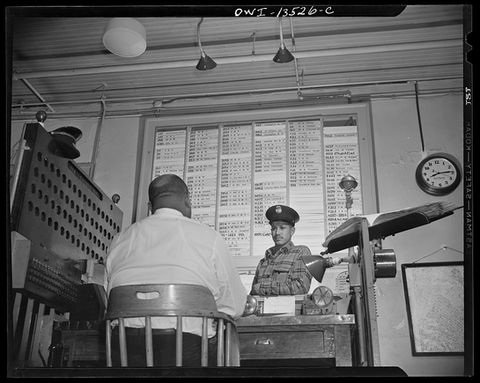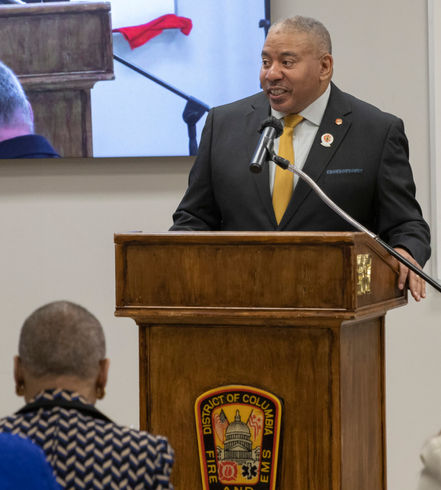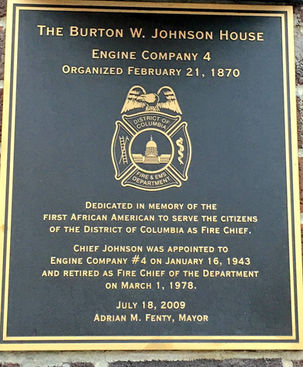
The Integration of African Americans
The DC Fire and EMS Department today has one of the highest percentages of African American employees of fire departments across the country. The uniformed workforce is 48% African American; nationally, 8% of firefighters are African American. But it was not always this way. This page tells the story of the journey taken to get to today’s place of pride in the Department’s diversity.
John S. Brent:
First African American DC Firefighter
John S. Brent
John S. Brent was the first African American firefighter in Washington, DC. He was hired in August of 1868 and was assigned to Union Engine Company No. 1, three years before the volunteer and paid fire companies in the District of Columbia were combined into the DC Fire Department, a fully paid career department.
Engine 4: The Hornet’s Nest
Source: Washington Informer
About 48 years later, three African American firefighters - Privates Charles E. Gibson, Frank Hall, and Richard J. Holmes (grandfather of DC Congresswoman Eleanor Holmes Norton) - petitioned the Chief Fire Engineer and Fire Commissioner to organize an all-African American unit in the Department. They did so because they were denied command opportunities and career advancement on the basis of their race.
That petition was granted on April 13, 1919. The first African American unit was Engine Company 4, which started as the South Washington Fire Company in 1870 before the creation of the modern DC Fire Department.
In 1940, Engine Company 4 – nicknamed the Hornet’s Nest – relocated from New Jersey Avenue and B Streets, SE, to 931 R Street NW, where the company was responsible for overseeing the protection of U Street, then referred to as “the Black Broadway.”
Engine 4 was moved to its current location at 2531 Sherman Avenue NW in 1976.
In 1943, Gordon Parks – a prominent African American photojournalist, author, and film director – spent time at Engine 4. His visits resulted in a photo essay containing 88 photos that are currently housed at the Library of Congress. The following (below) is a sample of the Parks collection. This collection demonstrates that while the Department’s technology, equipment, and protocols have significantly advanced in the decades since, much of firehouse life and culture remains the same.
Gordon Parks’ Photos
Source: Library of Congress, Prints & Photographs Division
Integration and the
Progressive Firefighter's Association
For the 40 years following the establishment of Engine 4 and three other firehouses (Engines 13, 19, 27 and Truck 10) as a fully African American firehouse, Black firefighters were sporadically hired by the Department, but it remained as a whole majority White and often hostile to Black applicants and employees. Black firefighters were required to sleep in designated cots and use designated plates and cutlery in firehouse kitchens. This was despite the city’s climbing African American resident population, which reached 54% in 1960 and then 70% in 1970.
In the early 1960s, one of the District’s three Commissioners who would later serve as its first elected Mayor, Walter Washington, initiated an effort to recruit hundreds more African Americans into the Department, with the goal of having at least one Black firefighter in each firehouse on each shift. One of those firefighters was Willie Drummond, who has provided an oral history interview for this exhibit. After the Department was integrated, the Black-only firehouses were eliminated.
In 1968, Black DC firefighters established the Progressive Fire Fighter’s Association of Washington DC (PFFADC). Its first President was Rayfield Alfred, who also provided an oral history interview. The Progressives came together to cultivate “the idea to unite Black fire fighters and communities in the struggle to contest the injustices that exist in the fire service and in our local communities. This cultivation led to the unification of efforts to take a stand for social justices in, what was then known as, the District of Columbia Fire Department (DCFD).” In 1970, these same firefighters met in New York City with Black and minority firefighters from jurisdictions across the United States and formed the International Association of Black Professional Fire Fighters.
Retired Fire Chief
Rayfield Alfred
Rayfield Alfred was born and raised in a little French Creole town in Louisiana called Ville Platte. He went to college at Southern University in Baton Rouge and then entered the military with the 101st Airborne. He served as a paratrooper from 1958 to 1961 and was stationed at Ft. Campbell, Kentucky, where he saw an ad in the post office that said, "Come be a firefighter in the Nation's Capital." Alfred joined the DC Fire Department in 1963 where he was assigned to Truck 17. He and his African American peers faced racism within the firehouses where they were denied the ability to eat meals with the White firefighters. They also faced discrimination in promotions and within their own firefighters’ union. For these reasons, they formed the Progressive Firefighter's Association of Washington, DC and Alfred served as its first President. When he was promoted to Sergeant, he went to Truck 6, and then went to the Training Academy where he worked as an Instructor through the rank of Lieutenant. He returned to the field as a Lieutenant at Engine 21 and then served as a Captain and chief officer in the Office of the Fire Chief where he held a variety of positions, including Public Information Officer and Special Assistant. He was promoted to Assistant Fire Chief of Operations by Fire Chief Theodore Coleman. Mayor Marion Barry appointed Alfred Fire Chief and he served in that position from 1988 to 1993. Following his retirement from DC, he served as the first African American Fire Chief of the Jacksonville, Florida Fire and Rescue Department.
Retired Lieutenant
Garry Wiggins
Garry Wiggins joined the DC Fire and EMS Department in 1986, rising through the ranks to retire as a Lieutenant in 2017. He oversaw operations for events in the District, such as the Million Man March, and was among those who responded at the Pentagon on September 11, 2001. He currently serves as the President of the Progressive Fire Fighters Association of Washington, DC.
Retired Captain
Romeo Spaulding
Romeo Spaulding served the DC Fire and EMS Department from 1965 to 1992, retiring at the rank of Captain. He was the fourth President of the PPFAC and also served as President of the International Association of Black Professional Firefighters. At the Department, he rose through the ranks to become Director of Community Relations and Public Fire Safety Education. He also served on the Advisory Board of the Congressional Fire Services Institute, on the executive board of the National Black Leadership Roundtable, as a member of the board and Treasurer of the Black Congress on Health, Law, Economics, and as the United Nations representative for Black Firefighters on the International Human Rights Association of America.
Retired Lieutenant Willie Drummond
Willie Drummond joined the Department in 1963 after serving in the US Navy and during the city's historic effort to integrate the Department. He never imagined becoming a firefighter because his father was burned to death in an occupational accident while working as a boiler tender at the US Capitol’s power plant. But he ultimately followed friends into the Department and has never regretted his decision. As Drummond said repeatedly during his oral history interview, the Department gave him opportunities that he never could have dreamed of as a child. Listen to Drummond’s interview and learn about his time spent at the Department from 1963 to 1995. He served at Engine 17, Engine 8, the Fire Prevention Division, the Training Academy, and Engine 5. He retired at the rank of Lieutenant. During his retirement years, Drummond worked for the federal government and
the private sector. He travelled all over the world providing fire safety and prevention training to corporations, government agencies, embassies, and the military.
African American Trailblazers
Fire Chief Burton Johnson:
First African American DC Fire Chief
The Department’s first African American fire chief was Burton Westbrooke Johnson, who was born in Philadelphia, Pennsylvania and moved to Washington, DC in his youth. He was appointed to Engine Company 4 on January 16, 1943, and also served in the US Army during World War II. After returning to the DC Fire Department, he became the first Black Sergeant, Black Lieutenant, and Black Captain-Commander in the Fire Prevention Division. He also was the first Black Battalion Fire Chief and first Black Fire Marshal in the Department. While Fire Marshal, he established innovative fire prevention, education, and community outreach programs, including smoke alarm give-away programs that resulted in significant decreases in fire fatalities in Washington, DC. In 1973, Mayor Washington appointed him Fire Chief. He served in that role until March 1, 1978. Chief Johnson passed away in 2007. On July 18, 2009, DC Mayor Adrian Fenty dedicated Engine 4 in memory of Chief Johnson.
Hammon vs. Barry
The integration of the Department did not happen without controversy. In March 1984, Black firefighters filed a class action lawsuit against the city alleging discrimination in hiring, working conditions, and promotions. One year later, White firefighters filed a lawsuit alleging reverse discrimination. In 1990, the US District Court approved a settlement agreement between all of the parties that provided a $3.5 million lump-sum payment from the city to the black firefighters; 180 immediate promotions to fill most outstanding vacancies; the creation of a new platoon of firefighters with many new Sergeant, Lieutenant, and Captain positions; and the development and administration of fair promotional examinations to fill some outstanding and all future vacancies. See Hammon v. Barry, 752 F. Supp. 1087 (D.D.C 1990).
The Cadet Program
One of the ways the Department recruited African Americans to the Department following the Hammon settlement was through the Cadet Program. Started in 1986 under the leadership of Mayor Marion Barry, Fire Chief Theodore Coleman, Battalion Fire Chief Garland Graves, and Lieutenant Phillip Proctor, the Cadet Program recruited DC resident graduates of DC high schools to join a year-long program at the Training Academy preparing them to graduate as DC firefighters. The motto of the program is: “each on, teach one.” Since 1986, hundreds of cadets have graduated and attained every rank in the Department but Fire Chief. The Department celebrated the Cadet Program’s 35th Anniversary in 2021 with a special event at the Training Academy and the dedication of a corridor to Retired Lieutenant Phillip Proctor.
Source: Food on the Stove, 2024
Today
From the 1960s to the present, the percentage of African American firefighters and Department command officials steadily climbed. Black firefighters have served in large numbers at every rank, including 11 as Fire Chief since 1973. Today, 48% of DC firefighters are African American. Nationally, only 8% of firefighters are Black.
During Black History Month in 2023, DC Fire and EMS Chief John Donnelly and his Executive Leadership Team joined with the PFFADC to name DC Congresswoman Eleanor Holmes Norton Honorary Fire & EMS Chief. This event took place almost 103 years after Congresswoman Norton’s grandfather successfully petitioned the city to create the first African American firehouse in Washington, DC.





















































